North Carolina is famous for a few things, namely for being the birthplace of flight, Pepsi, and Krispy Kreme donuts. Yet, The Tar Heel State also boasts a rich natural heritage. It contains diverse geographic zones including the Appalachian Mountains and the Atlantic Coastal Plain. The state is home to many species of plants and animals including eastern box turtles and coyotes. You can also find numerous spiders throughout the state, from poisonous widows to harmless orb weavers. Here is a list of 10 spiders in North Carolina that make their homes in The Tar Heel State.
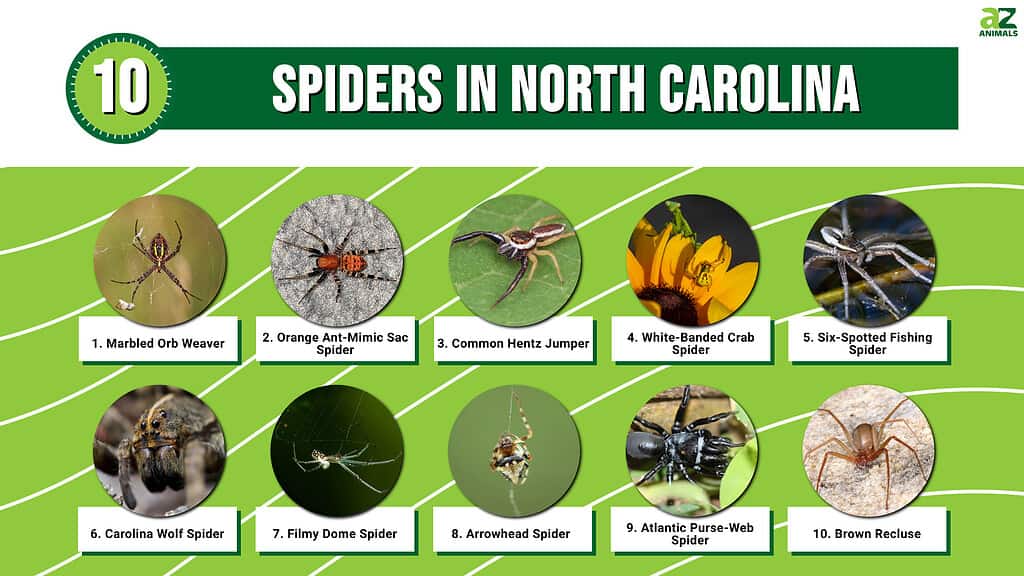
#10. Brown Recluse
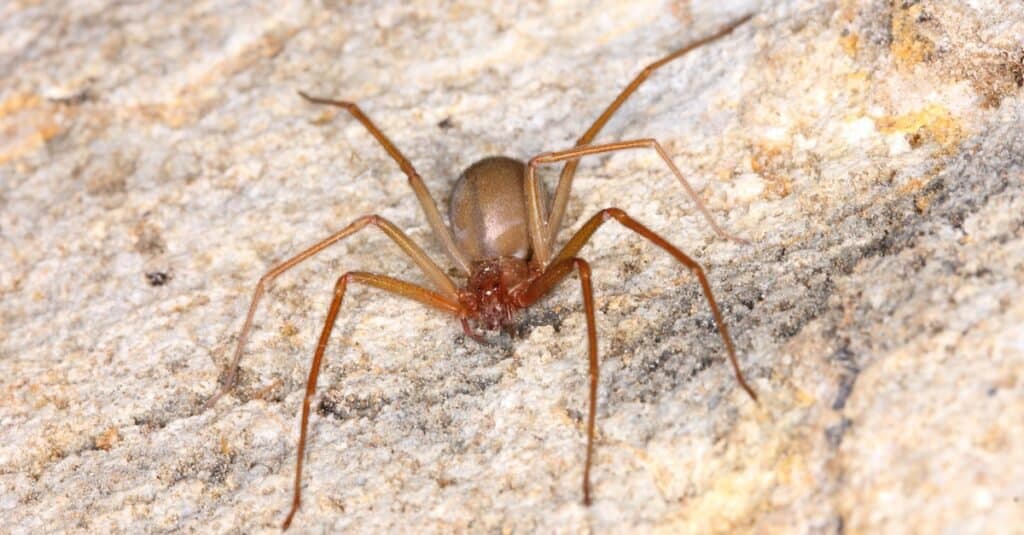
The brown recluse spider is one of the most dangerous spiders in the United States.
©Pong Wira/Shutterstock.com
The brown recluse, Loxosceles reclusa, easily ranks among the dangerous spiders in North Carolina. It belongs to the family Sicariidae, which includes more than 160 different species known for their necrotic venom. A bite from a brown recluse can cause vomiting, fever, muscle aches, and nausea.
Adult brown recluses measure between 6 and 20 millimeters long, with males measuring smaller than females. Generally speaking, most specimens appear either light or dark brown or grey. They often feature a dark, violin-shaped marking on the upper side of the cephalothorax. Other names for brown recluses include fiddleback spiders or violin spiders due to this unique mark.
You can often find brown recluses in the U.S. in dark, dry environments such as cellars, closets, garages, or woodpiles. Although they build asymmetrical webs, they are active hunters that leave the safety of their webs to catch their prey. Despite their potent venom, they rarely act aggressively towards humans.
#9. Atlantic Purse-Web Spider

The Atlantic purse-web spider builds a tube-shaped web that it hides in to ambush prey.
©iStock.com/ArendTrent
Sphodros atlanticus is better known as the Atlantic purse-web spider. It belongs to the family Atypidae, also known as atypical tarantulas or purse-web spiders. You can find these spiders in North Carolina and throughout the eastern United States.
Adult females measure around 25 millimeters long, while males measure noticeably smaller. They appear almost entirely black. Like other members of their family, the cephalothorax and abdomen look roughly the same size. Additionally, they feature disproportionately huge chelicerae and long spinnerets.
Atlantic purse-web spiders are ambush hunters. They build silken tubes along the ground or against tree trunks that they hide inside. When prey wanders past the entrance, they dart forward and drag it inside the tube. Despite their large size and huge mouthparts, they pose little threat to humans.
#8. Arrowhead Spider

The arrowhead spider gets its name from its unique, triangle-shaped abdomen.
©Rusty Dodson/Shutterstock.com
The arrowhead spider, Verrucosa arenata, is one of the most unusual-looking spiders in North Carolina. A member of the orb weaver family Araneidae, it also goes by the names the triangle orb weaver and arrowhead orb weaver. You can find it throughout North America, particularly in humid climates that get plenty of sunshine.
Adult females measure 7 to 14 millimeters long while males measure 4 to 6 millimeters long. They possess a unique triangle-shaped abdomen that looks similar to an arrowhead, hence their name. The legs and carapace appear red, black, or brown. Meanwhile, the top of the abdomen almost always looks yellow or white.
While most orb weavers hang upside down, arrowhead spiders sit facing upwards in their webs. Additionally, unlike the webs of most other orb weavers, the central section of an arrowhead spider’s web lacks radial threads. They possess unusually strong silk that aids them in catching prey.
#7. Filmy Dome Spider

The filmy dome spider builds a dome-shaped web that it uses to capture its prey.
©iStock.com/Tanuza
Neriene radiata, or the filmy dome spider, belongs to the sheetweaver spider family Linyphiidae. It easily ranks as one of the smallest spiders in North Carolina. Outside of the state, you can find it throughout much of the United States and Canada.
Even when fully grown, adult filmy dome spiders rarely measure more than 4 millimeters long. Furthermore, 4 millimeters is the maximum size for females, with males measuring smaller. They appear predominantly white except for a few dark markings and a brown stripe down the center.
As their name implies, filmy dome spiders construct dome-shaped webs that they use to catch prey. They hunt by hanging upside down from the top of the dome until insects wander into their webs. Due to their small size, their bite poses no threat to humans.
#6. Carolina Wolf Spider
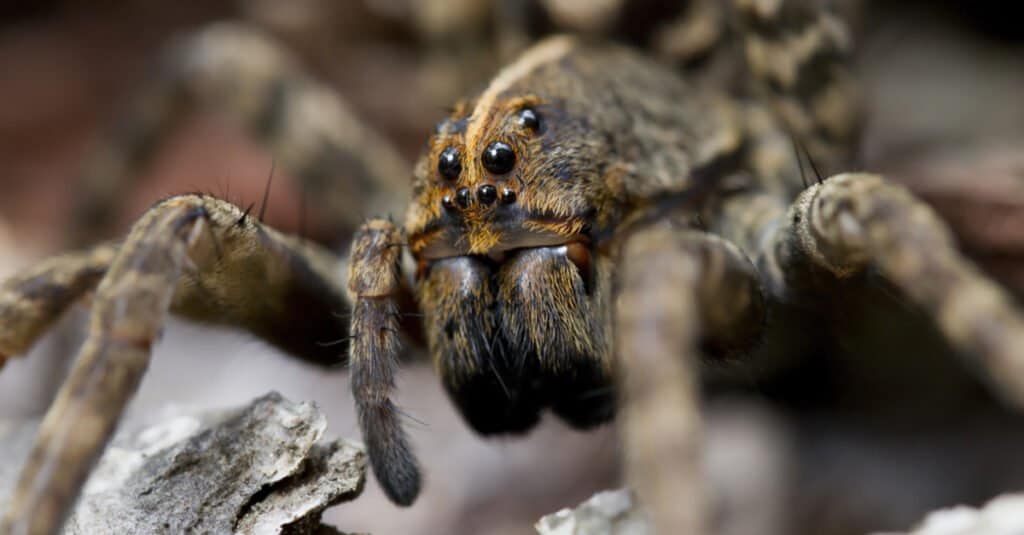
The Carolina wolf spider can reach nearly 50 millimeters long with its legs extended.
©Will E. Davis/Shutterstock.com
Hogna carolinensis, or the Carolina wolf spider, belongs to the wolf spider family Lycosidae. It ranks among the largest wolf spiders in North Carolina. You can find it throughout North America in varied environments, although it prefers flatter, more open areas.
Adult females measure from 22 to 35 millimeters long and males measure 18 to 20 millimeters long. They appear primarily light brown but also sport several dark brown markings on the abdomen and the cephalothorax. Furthermore, males feature orange coloration on the sides. Their eyes reflect light exceptionally well, which can help you identify them at night.
Like other members of their family, Carolina wolf spiders are active hunters that don’t use webs to capture prey. They hunt by waiting near the edge of their burrows and attacking when insects wander too close. Their venom can simultaneously paralyze and immobilise their prey but poses no threat to humans.
#5. Six-Spotted Fishing Spider
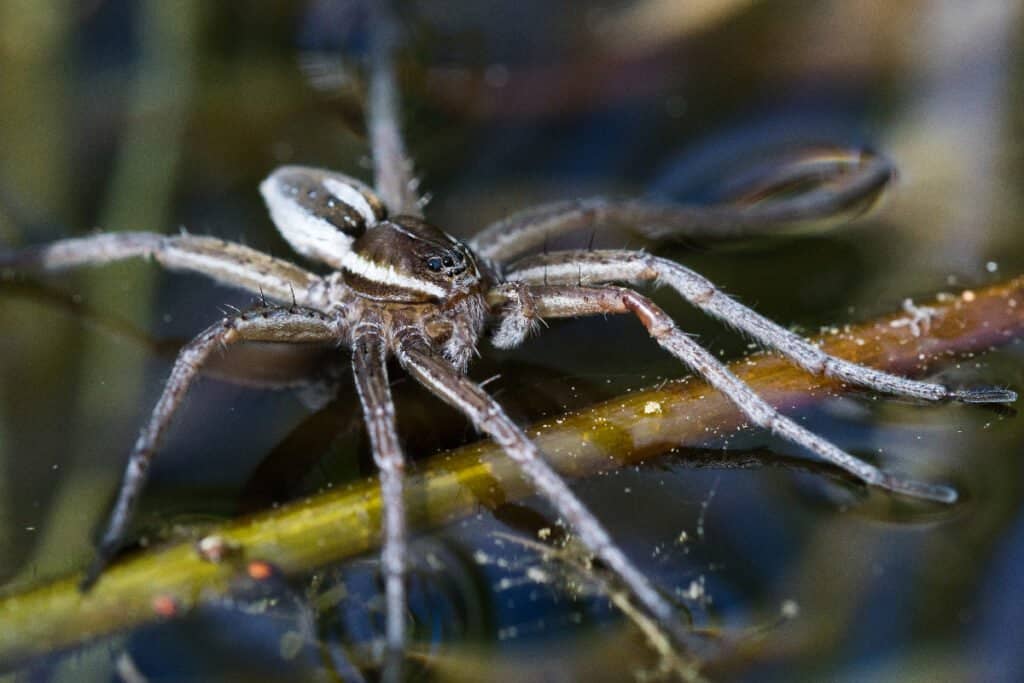
The six-spotted fishing spider can catch fish more than five times its own size.
©Jukka Jantunen/Shutterstock.com
Dolomedes triton is more commonly known as the six-spotted fishing spider. It belongs to the nursery web spider family Pisauridae. You can find these spiders in North Carolina, particularly near wetlands or other bodies of water.
Adult females measure between 15 and 20 millimeters long and males measure from 9 to 13 millimeters long. They appear predominantly grey or brown except for a whitish-cream stripe down each side of the body. The top of the abdomen features light spots, while the bottom sports 6 dark spots, hence their name.
Like other members of their family, six-spotted fishing spiders do not build webs to capture prey. Instead, they typically hunt by using their legs as fishing lures to snag insects or small fish from the water. They can also run across the surface of the water or even dive under its surface to capture their prey.
#4. White-Banded Crab Spider

The white-banded crab spider ambushes insects that come to visit flowers.
©Georgi Baird/Shutterstock.com
The white-banded crab spider, Misumenoides formosipes, is a member of the crab spider family Thomisidae. It is one of several crab spiders in North Carolina and also ranges throughout much of the United States.
Female white-banded crab spiders measure from 5 to 11 millimeters long and males measure 2.5 to 3.2 millimeters long. They get their name from a characteristic white line that runs through the space below their eyes. Although they can vary in color, females typically appear white or yellow. Meanwhile, males look primarily dark brown except for the abdomen, which looks gold. They can walk forward, backward, and sideways like a crab.
White-banded crab spiders are active hunters that do not build webs to capture prey. When hunting, they often ambush pollinating insects that visit flowers where the spiders like to sit and wait. Their bite is not medically significant.
#3. Common Hentz Jumper

The common Hentz jumper uses its eyesight and jumping ability to capture its prey.
©spidereyes2020 / flickr – License
Another name for Hentzia palmarum is the common Hentz jumper. It belongs to the jumping spider family Salticidae and ranges throughout the southeastern United States. You can also find it in Cuba, the Bahamas, and parts of Hawaii.
The common Hentz jumper is one of the smaller jumping spiders in North Carolina. On average, most specimens measure between 3 and 5 millimeters long, with females measuring larger than males. The female looks mostly whitish, although the top of the cephalothorax and abdomen appears slightly darker. Meanwhile, the male has a light brown cephalothorax and abdomen and a white stripe down both sides.
Like other members of its family, the common Hentz jumper has keen eyesight and can leap long distances. It relies on these abilities to catch its prey rather than using a web. Due to its small size, it poses little threat to humans.
#2. Orange Ant-Mimic Sac Spider
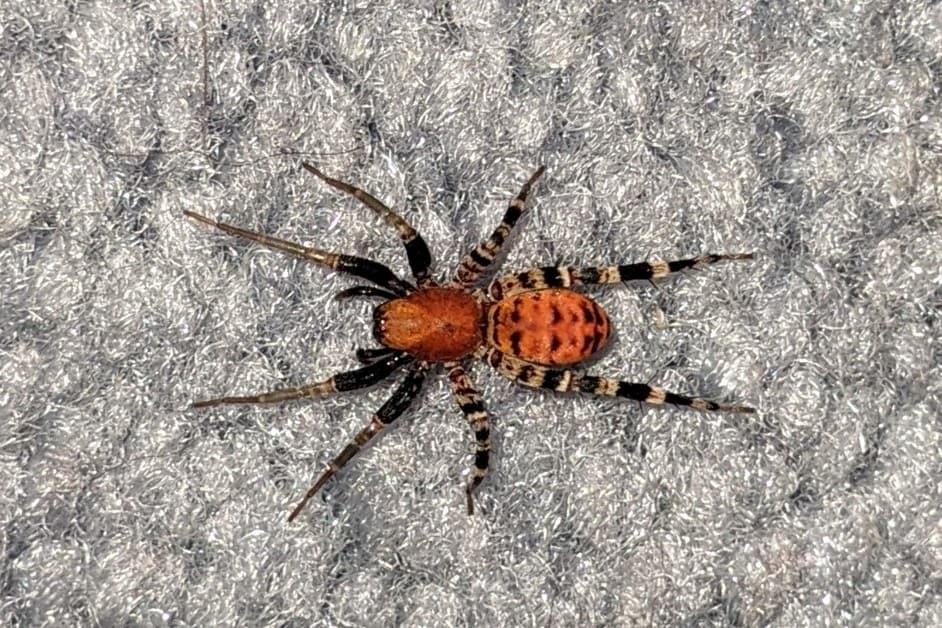
The orange ant-mimic sac spider poses as an ant in order to sneak up on its prey.
©jeanetx / jeanetx, CC0, via Wikimedia Commons – License
Castianeira amoena is sometimes also called the orange ant-mimic sac spider. That said, due to a lack of formal study it normally goes by its scientific name. It belongs to the family Corinnidae, or corinnid sac spiders. You can find these spiders in North Carolina as well as throughout much of the United States and Mexico.
Adult orange ant-mimic sac spiders measure around 7 to 10 millimeters long, with females measuring larger than males. They appear predominantly orange aside from black median stripes down the abdomen and on the legs, hence their name.
Orange ant-mimic sac spiders do not use webs to catch their prey. As their name implies, they mimic the appearance of ants in order to help them sneak up on their prey. They accomplish this by using their front legs as antennae, which confuses the ants into thinking they’re one of their own.
#1. Marbled Orb Weaver
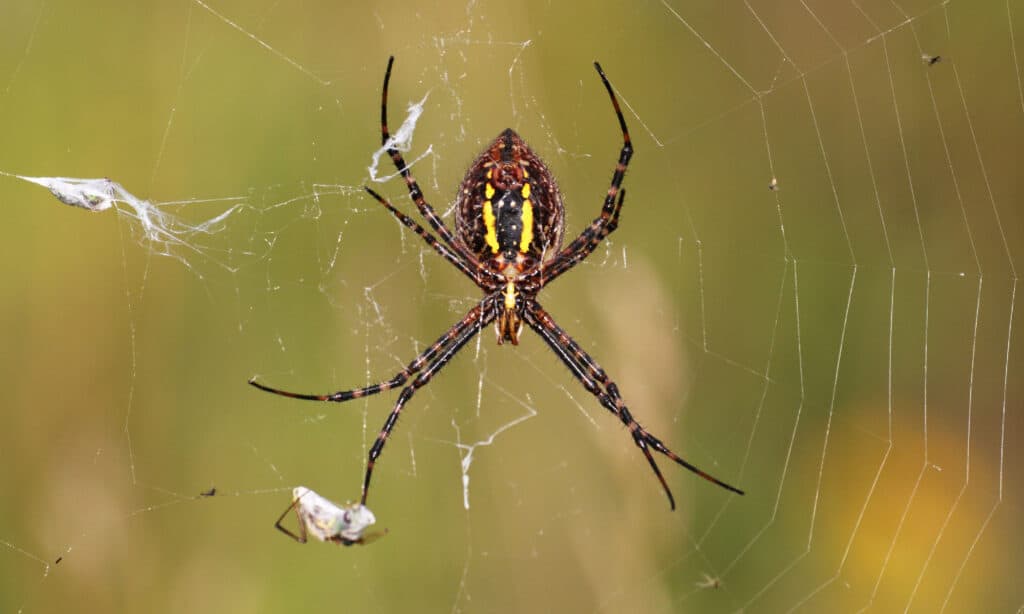
The marbled orb weaver features striking markings on its abdomen.
©iStock.com/mirceax
Araneus marmoreus, or the marbled orb weaver, is the second orb-weaver to make our list of spiders in North Carolina. You may also know it as the pumpkin spider, due to the female’s large, orange abdomen. You can find it in wooded areas throughout the northern hemisphere.
Adult females can reach up to 18 millimeters long. Meanwhile, males typically only measure 9 millimeters long. The females often have a large, bulbous abdomen covered in dark markings, so people sometimes call them pumpkin spiders. However, some specimens look almost white instead of orange and feature only a single dark patch near the rear rather than markings along the whole abdomen.
Marbled orb-weavers build vertically-oriented webs that they use to capture prey. They hide during the day and emerge at night to feed on insects stuck in their webs. Their bite is not medically significant.
Summary of 10 Spiders in North Carolina
Here’s a recap of the 10 spiders found in North Carolina that we took a look at.
| Number | Spider | Scientific Name | Range |
|---|---|---|---|
| 1 | Marbled Orb Weaver | Araneus marmoreus | Wooded areas throughout the northern hemisphere |
| 2 | Orange Ant-Mimic Sac Spider | Castianeira amoena | Much of the United States and Mexico |
| 3 | Common Hentz Jumper | Hentzia palmarum | Southeastern U.S., Cuba, the Bahamas, Hawaii |
| 4 | White-Banded Crab Spider | Misumenoides formosipes | Much of the U.S. |
| 5 | Six-Spotted Fishing Spider | Dolomedes triton | Near wetlands or other bodies of water in North Carolina |
| 6 | Carolina Wolf Spider | Hogna carolinensis | Throughout North America in varied environments, though it prefers flatter, more open areas |
| 7 | Filmy Dome Spider | Neriene radiata | Much of the U.S. and Canada |
| 8 | Arrowhead Spider | Verrucosa arenata | Throughout North America, particularly in humid climates that get plenty of sunshine |
| 9 | Atlantic Purse-Web Spider | Sphodros atlanticus | Throughout the eastern U.S. |
| 10 | Brown Recluse | Loxosceles reclusa | In the U.S. in dark, dry environments such as cellars, closets, garages, or woodpiles |
The photo featured at the top of this post is © sippakorn/Shutterstock.com
Thank you for reading! Have some feedback for us? Contact the AZ Animals editorial team.






